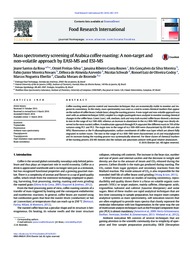Mass spectrometry screening of Arabica coffee roasting: A non-target and non-volatile approach by EASI-MS and ESI-MS.
Mass spectrometry screening of Arabica coffee roasting: A non-target and non-volatile approach by EASI-MS and ESI-MS.
Autoria: ROSA, J. S. da; FREITAS-SILVA, O.; ROUWS, J. R. C.; MOREIRA, I. G. da S.; NOVAES, F. J. M.; AZEVEDO, D. de A.; SCHWAB, N.; GODOY, R. L. de O.; EBERLIN, M. N.; REZENDE, C. M. de
Resumo: Coffee roasting needs precise control and innovative techniques that are economically viable to monitor and improve its consistency. In this study, mass spectrometry was used as a tool to screen chemical markers that appear on the surface of coffee beans (whole bean) along the roasting process. A non-target and non-volatile approach was used with an ambient technique (EASI) coupled to a single quadrupole mass analyzer to monitor roasting chemical changes in the coffee bean. Green (raw), soft, medium, dark and very dark roasted coffee beans showed a decrease in ions in the range of m/z 500–600, whereas an increase in abundance in the m/z 800–900 range was clearly observed in the most roasted coffees. A multivariate approach through PCA separated the different roasts in 70% of the variance using PC1 and PC2. The major ions in the range of m/z 500–600 were characterized by ESI-MS and also HPLC-fluorescence as the N-alkanoyltryptamides, surface constituents of coffee wax layer which are almost fully degraded in darker roasts. The ions in the range of m/z 800–900 were characterized as di-and triacylglicerols and its increase during the roasting process was systematically observed. For these classes of chemical markers of the roasting process, ESI-MS showed also the sodium and potassium adducts with good relative abundances.
Ano de publicação: 2016
Tipo de publicação: Artigo de periódico
Unidade: Embrapa Agroindústria de Alimentos
Observações
1 - Por padrão são exibidas publicações dos últimos 20 anos. Para encontrar publicações mais antigas, configure o filtro ano de publicação, colocando o ano a partir do qual você deseja encontrar publicações. O filtro está na coluna da esquerda na busca acima.
2 - Para ler algumas publicações da Embrapa (apenas as que estão em formato ePub), é necessário ter, no celular ou computador, um desses softwares gratuitos. Sistemas Android: Google Play Livros; IOS: iBooks; Windows e Linux: software Calibre.
Acesse outras publicações
Acesse a Base de Dados da Pesquisa Agropecuária (BDPA) para consultar o acervo completo das bibliotecas da Embrapa.

